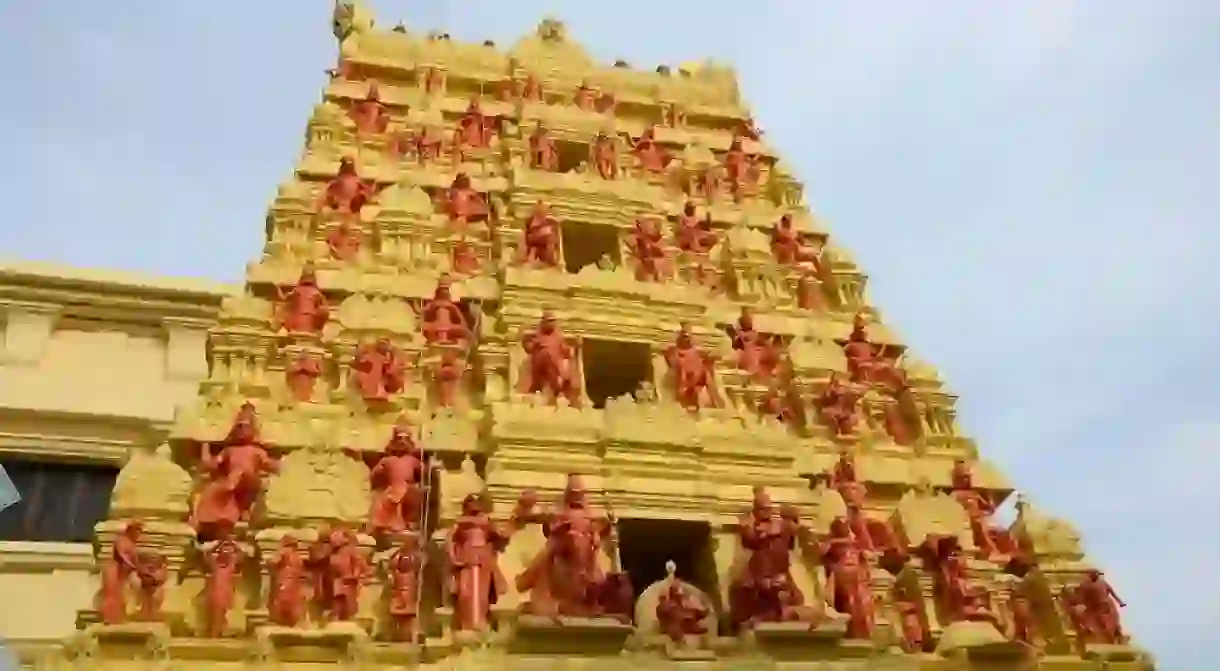The Most Beautiful Hindu Temples in Singapore

Hinduism has a long history in Singapore, but the arrival of Hindu immigrants (mainly the Tamil people) allowed Singapore’s Hindu architectural legacy to shine. The agamic styles popular in South India, famous for intricate front towers and high ceilings, interspersed with decorative motifs and emblems, are hallmarks of Hindu design. These Hindu temples are some of the most beautiful sights in Singapore.
Did you know – Culture Trip now does bookable, small-group trips? Pick from authentic, immersive Epic Trips, compact and action-packed Mini Trips and sparkling, expansive Sailing Trips.
Sri Thendayuthapani Temple
Hindu Temple

Built in 1859 and recently gazetted as a national monument, Sri Thendayuthapani Temple was constructed by the Nattukottai Chettiar community, who are devoted Shaivites. Thendayuthapani (also known as Murugan, Subramaniam and Kartikeya), is a popular deity amongst the Tamil population. During the festival of Thaipusam, this spot is packed, as it’s the final stop of the procession. The temple itself is stunning, with an arched and colourful gopuram (ornate gatehouse tower) and steps that lead you ominously toward the central shrine of the chief deity.
Sri Senpaga Vinayagar Temple
Hindu Temple

The most striking feature of Sri Senpaga Vinayagar Temple is the gopuram that contains elegant gold and white shades. Devoted to the god Ganesha, famous for his elephant head, there’s a bit of mystery behind this shrine’s construction. It is believed that a statue of Ganesha (also known as Vinayagar, and the brother of Murugan), was discovered beside a pond. In response, the Hindu community, specifically the Ceylonese (Sri Lankan) Hindus, built this temple due to the significance of this mysterious discovery.
Sri Vadapathira Kaliamman Temple
Hindu Temple

Located within the Little India neighbourhood, Sri Vadapathira Kaliamman Temple started out as a humble shrine (believed to be dated as far back as the 1830s), and then became the impressive temple it is today. It is unique due to its less elaborate gopuram, which is smaller but contains larger figures of deities. There are also carved figures at the front entrance near the doorway that are larger than those at most temples. A deep teal hue is plastered over the walls of this temple that’s dedicated to the goddess Kaliamman.
Sri Srinivasa Perumal Temple
Hindu Temple

Built in honour of the deity Vishnu, this gazetted national monument is popular for being the starting point of the annual Thaipusam festival that celebrates Lord Murugan, the God of War and son of Shiva. The building of Sri Srinivasa Perumal Temple was a community effort, and people raised money to construct this spot. Often, gopurams tell a story. This temple’s gopuram depicts Vishnu’s various avatars. Entering the site, you will encounter different statues that depict someone who is important to Vishnu, like Garuda, a bird-like deity.
Sri Veeramakaliamman Temple
Hindu Temple

Sri Veeramakaliamman Temple was consecrated in honour of Kali, one of the more ferocious Hindu deities and a consort of Shiva. It is no wonder that Bengali immigrants built this shrine, as Bengal has historically been linked to Kali. However, what stands out is the Dravidian design of this temple. This style is likely connected to the Tamil influence on the island and its impact on Hindu temple design. This temple showcases how a particular design can be adapted.
Sri Sivan Temple
Hindu Temple
Sri Sivan Temple is one of the few temples that experienced a massive transformation since its development, after being moved several times. Currently located in the Geylang area (with the present look dating back to 1993), it was constructed with the help of skilled artisans, craftsmen and architects from India, who blended various regional Hindu traditions. The temple stands out because of its calm, cream shade and wide open halls, opposed to having a closed-off interior and bright colours, like other Hindu sanctuaries. The design illustrates how Hindu architecture often focuses on innovative designs that cater to various deities.
Sri Siva Durga Temple
Hindu Temple
Built specifically for Shiva and Durga, the Goddess of War, Sri Siva Durga Temple is another stunning representation of Dravidian architecture. The gopuram has gold panelling at the top, which contrasts other parts of its design. The interior is a sight to behold, with numerous shrines and motifs that represent the intricacies of Hindu mythology.
Sri Mariamman Temple
Hindu Temple

As the oldest Hindu temple in Singapore, Sri Mariamman Temple has been serving worshippers as far back as 1827. It is also one of most important temples in Singapore. Besides being a significant temple for South Indian Hindus, it was also a social space for new immigrants, who did not have housing or jobs when they first landed in Singapore. The temple is dedicated to Mariamman, Goddess of Rain, who is believed to be the South Indian incarnation of the goddess Kali.
Sri Ruthra Kaliamman Temple
Hindu Temple
Built to respect Kali, the presiding deity, this hallowed sanctum has an overwhelming presence. The high ceilings and domineering entrance encapsulates this fierce goddess, who destroys evil forces. The temple looks archaic, with its harsh pillars below the multi-hued gopuram, which shows the key figures in Kali’s story.
Sri Krishnan Bagawan Temple
Hindu Temple

Adjacent to the Kwan Im Thong Hood Cho Temple, a popular traditional Chinese Buddhist temple, this is the first Hindu temple that was built for Krishna in Singapore (one of the avatars of Vishnu, and his consort Rukmini). Sri Krishnan Bagawan Temple has a bright blue front entrance, featuring various avatars of Vishnu and Garuda. The top of the arched entrance also depicts a wedding, with two large deities standing at different sides of the entrance. This temple is a good representation of the rules that are described in Agama Sastra, a Hindu guide on temple construction.












